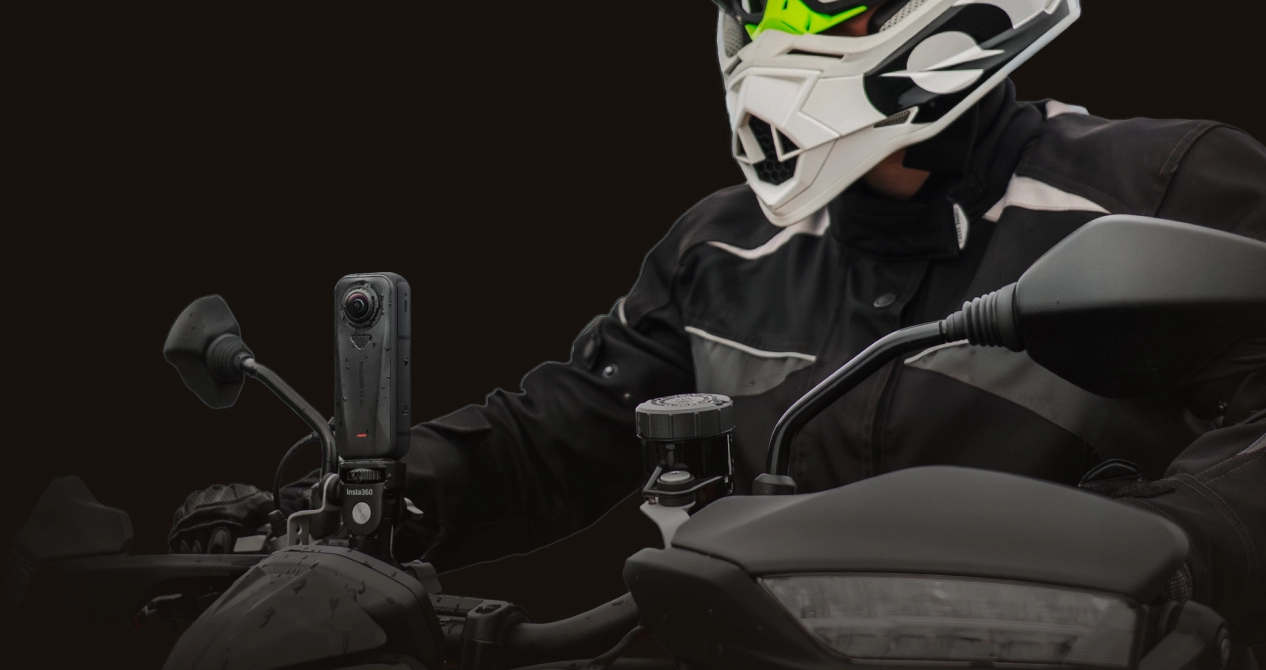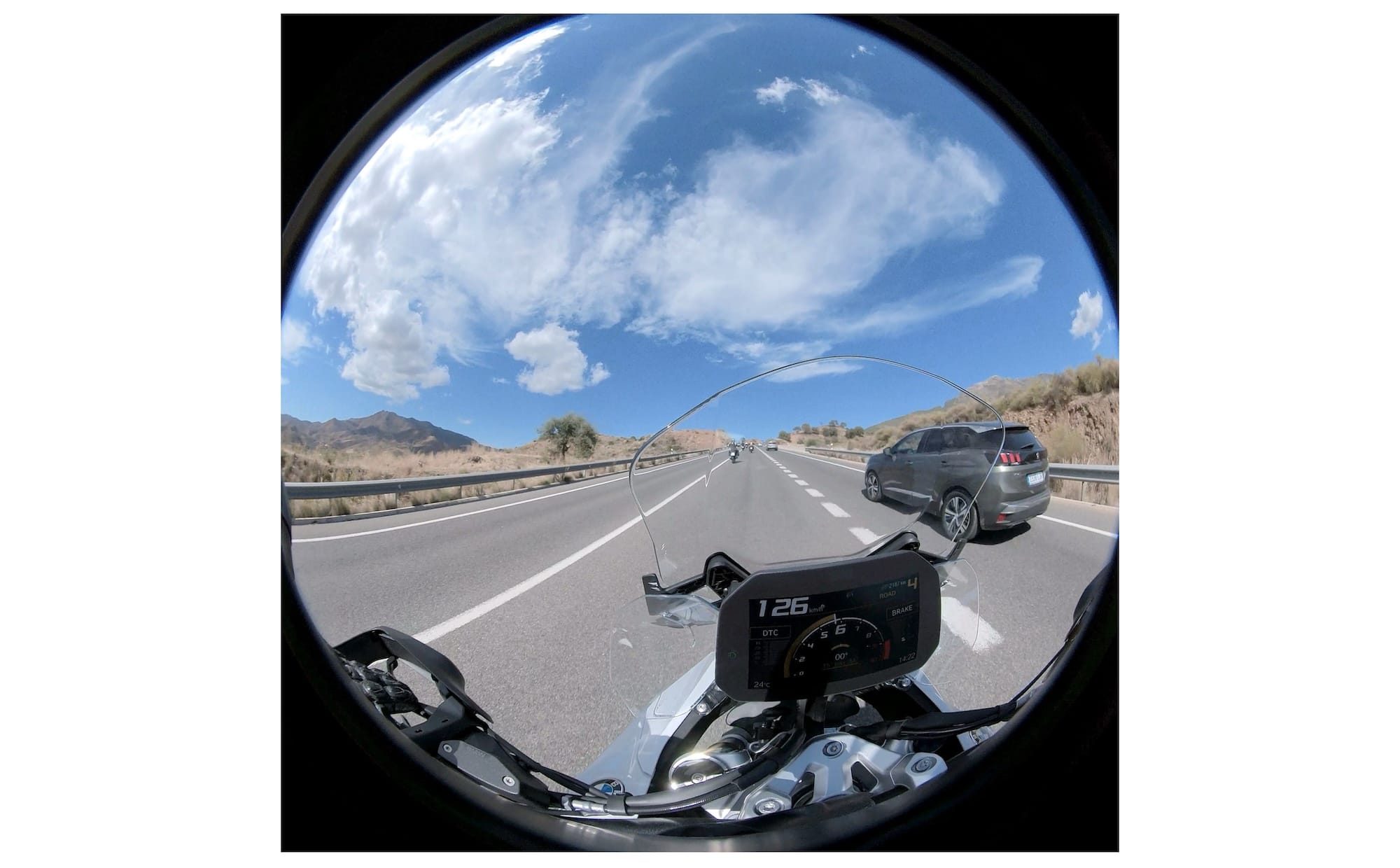Best 360-Degree Action Cameras for Motorcyclists

Recording your motorcycle adventures on video is a fantastic way to share them with family and friends who weren’t there for the ride. Investing in a 360 action camera allows you to capture everything that’s going on throughout the entire ride.
However, there are a lot of action cameras on the market, and they can seem virtually identical, especially to beginner videographers. How are you supposed to pick the kind of camera that fits your needs?
We’ll tell you. This article gives you an overview of how motorcyclists use 360 action cameras and suggests models that are right for you.
What Is a 360 Action Camera?
Action cameras are ultra-compact, highly portable, and (typically) very rugged cameras that can be attached to places where larger cameras simply don’t fit. They can be mounted on motorcycle helmets or fairing, or places like a paraglider’s harness.
These types of cameras also tend to have wide-angle lenses to capture as much of the surrounding environment as possible to showcase the location of your adventure. However, 360 action cameras take this to the extreme.
A 360-degree action camera—as the name implies—captures a complete view of everything around you. By using two or more lenses, they record several shots at once and stitch them together to form a full 360-degree view.

However, this also means that the footage will look strange straight out of the camera. As a major drawback, you will require the manufacturer’s proprietary software (like the Insta360 Studio) or 360-degree plugins in regular video editors to be able to render the footage as a flat video projection.
Why Riders Use 360 Motorcycle Action Cameras
Action cameras have exploded in popularity among motorcyclists (and many other motorsports and extreme sports enthusiasts) for a good reason. They make recording your moto adventures for posterity fast and flexible, and may even help you with insurance claims if something happens.
Some of the most significant advantages of using a 360 action camera on a motorcycle include:
- Exciting Footage: Perhaps the main draw of action cameras is that they make for excellent motorcycling videos. With a 360 action camera mounted on your helmet, you can record your ride exactly as you see it and share the experience with your family, friends, and online followers.
- No Need for Aiming: Since the camera records everything that happens around you, you will miss nothing in the footage. With a regular camera mounted on your bike, you might miss a wild animal that suddenly pops out of the bushes on the side of the road. With a 360 action camera, you can simply frame the video later to show the prancing beast.
- Smooth Stabilization: Modern action cameras feature sophisticated image stabilization systems, while advanced camera mounts boast gyroscopes and gimbals to keep the camera steady. They keep even the bumpiest off-road footage buttery smooth, making for excellent video.
- Editing Freedom: Thanks to the ultra-wide angle of 360-degree shots, you can easily frame the footage during editing to suit your needs. Whether you’re making vertical clips for TikTok, ride reviews for YouTube, a professional travel documentary for TV, or just shooting some video to show your friends, you got it.
- Insurance Protection: If you’re involved in a crash with another vehicle, having a running 360 action camera can help you with your insurance claim. A regular, forward-facing dash cam might miss an incident where you get hit from the back or side but, the all-seeing eyes of a 360 camera will capture all angles to support your claim.
Consumer 360 Action Cameras
Consumer-level 360 action cameras are the most common options for most motorcyclists. They provide an ideal balance between a compact size, good image quality, durability, and a relatively affordable price.
Most consumer action cams will fit in your palm and don’t weigh much. You can mount them on your helmet without worrying about the added weight pulling down on the lid.
These types of cameras reach up to 8K resolutions, depending on the model (although just 4K is more than enough for even professional YouTube work). Most are also waterproof or have waterproof shells sold as accessories, so a sudden downpour or a tip-over at a water crossing aren’t a concern.
As a cherry on top, the more low-end cameras sell for just a couple of hundred dollars, while the fancier ones are roughly double that.
Some of the most popular consumer 360 action cameras for motorcyclists include:
Insta360 X4/X3/One X2
The Insta360 X family of cameras represent an advancing succession of features, from the One X2 on the lower end and X4 at the top (there’s even the new X5 as the flagship model now). These cameras are known for their top-notch stabilization features, making them a great choice for shooting video on bumpy off-road trails.
One of the neatest features is Insta360 “invisible selfie stick” technology. The company’s proprietary camera stick disappears from the footage, giving you drone-like footage without a drone. You can easily mount the camera on your helmet or behind the rider for cool “chase cam” shots.
GoPro Max
GoPro is a staple name in the action camera field because the cameras simply work. The Max is no different, offering effortless 5.6K-quality 360 video at a very reasonable price point.
The camera also benefits from GoPro’s wide selection of mounts and accessories, making it easy to fix the Max virtually anywhere on your bike. That convenience does come at a price, but if you’ve ever worked with video, you know gear reliability and convenience can be priceless treasures.
Insta360 One RS (with 360 Mod)
Insta360’s One RS is a modular camera that has swappable 4K and 360 lenses. It’s a flexible hybrid solution that’s tailor-made for motorcycling content creators that need to switch between various kinds of footage without lugging around a lot of gear in their panniers.
As an added bonus, the One RS is super compact even when compared to other action cams. You won’t have to give up image quality, either, as the image quality is on par with other comparable cameras, like the GoPro Max.
Dashcam-style 360 Cameras
If you’re more interested in the security aspect than recording thrilling riding adventures, there are dashcam-type cameras that offer 360 recording for insurance evidence. These kinds of cameras are often installed more permanently than true action cams, mounting discreetly on motorcycle fairings or under seats.
When choosing a 360 motorcycle dashcam, make sure to pick one that offers continuous loop recording. This means that once the camera’s memory card fills, it begins overriding materials from the beginning of the current video. Loop recording ensures you won’t miss out on insurance evidence due to a full memory card.
Popular 360 motorcycle dashcams include:
Innovv K5 (with rear camera)
Innovv K5 boasts of having been the first 4K motorcycle dashcam on the market, and as such it’s a popular choice among motorcyclists. The 4K camera itself is front-facing, but you can get a 1080p rear-facing addon, giving you an all-around view. As a nice bonus, the main camera does have good enough picture quality that the footage will look nice if you decide to grab it for safekeeping.
Waylens Secure360
The Waylens Secure360 is a car dashcam, but it’s possible to install it on motorcycles as well, as many bikers have demonstrated. As a unique feature, the camera can connect to 4G mobile internet (U.S. only) to upload video to the cloud for storage as you ride. The video quality is not fantastic, so this camera is definitely only a security tool.
Smartphone-based 360 Cameras
Smartphone-based 360 cameras require a connection to your phone to function. This means you can control them remotely, which can be a bonus in some situations.
In general, however, phone-based cameras aren’t as rugged and durable as stand-alone devices. As such, they may not be well-suited for shooting actual riding footage.
That doesn’t mean they don’t have their uses, though. They can be great options for shooting helmet-off walk-rounds and capturing scenery and behind-the-scenes footage at a pullout or parking lot.
Insta360 One X2 (with Mobile Control)
The above-mentioned Insta360 One X2 also offers remote control through the Insta360 smartphone app. You can adjust camera settings, start and stop recording, preview footage, and more with your phone. If you’re looking for a more capable 360 camera that can still sync with your phone, this is it.
Ricoh Theta SC2/Z1
Japanese camera maker Ricoh offers the SC2 and Z1 360-degree camera models. They’re geared more toward social media influencers and business users, respectively, but riders can still put them to good use. Either camera is ideal for capturing high-resolution all-round video of the campfire or hotel lounge at the end of the ride.
Common Mounting Locations for Motorcycle 360 Cameras
So, you’ve bought your 360 action camera. Now, you’re wondering where you should mount it. There are enough mounts and accessories on the market for you to attach the camera wherever you want on your motorcycle or yourself, but you should pick the location based on the kind of footage you want to shoot.
Most common action camera mounting locations on motorcycles include:
- Helmet: Mounting the camera on your helmet allows you to capture the rider’s point of view, enabling your viewers to see what you see. The best idea is to mount the 360 camera on top of your helmet, as using a camera mount in front of the lid means your head will block half the view.
- Tall Rear Mount: Fixing the action camera behind the rider makes it possible to record dynamic chase cam-like footage without a drone. However, depending on how you attached the camera, remember that it may add some height to your riding setup.
- Handlebar: Fixing the camera on a handlebar offers a stable and front-focused filming platform. Your body will block the rear view, but that also means that you can frame the shot on yourself to highlight your reactions.
- Rear Rack or Tail: Mounting the camera in the rear provides the opposite angle of a handlebar-mounted camera. This is where the camera should go if you need to shoot footage of riders behind you (for example, if you’re a motorcycle tour leader).
- Crash Bars or Panniers: Crash bar or pannier mounts, with a suction cup or clamp, can offer unique camera angles and make it easy to capture the scenery. However, these mounting locations can make your camera vulnerable to damage in a fall.